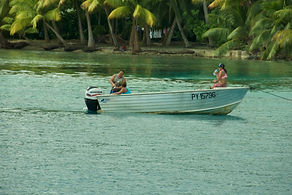Day Two, July 16: Sail From Raiatea to Baie D'Avea, Huahine


Sailing from Toahotu pass on the 16th of July, we made the 24 mile passage east to Huahine. This meant close-hauled motor-sailing against the trades. We approached the Avamoa pass into Fare, the main village in Huahine. The pass is only about 100 meters wide so we carefully lined up the ranges which are easlily seen on the hill overlooking Fare and came in on a bearing 128T.
On September 3rd, 1773, James Cook, on his Second Voyage of Discovery, attempted to tack his ship Adventure through the channel, missed stays and ran up on the reef. One approaches the inlet sailing east against the trades blowing east. The pass is narrow, and timing had to be perfect to tack a 100 ft ship into the harbor. A launch was used to kedge the ship off of the reef with little damage.
Cook implies that this was all in day's work, but the waves that we saw coming into the pass were anything but benign.

The Ranges at Fare harbor

Cook's 1769 Map of Avamoa Pass and Fare (Owharre) Harbor.
Printed with permission of The State Library of NSW
I'm a paragraph. Click here to add your own text and edit me. It's easy.

Waves on the reef at Avamoa Pass
Raiatea in the background





We motored down the west side of the island inside the lagoon to Baie d'Avea. This was a beautiful anchorage, well protected from the trades. One approaches from the north. The water is fairly deep until you approach the sandy shelf near the shore. We anchored in 30 ft water just next to the sandy shelf which shallows rapidly. When I skin dove over the anchor to check the holding ground, I could see the anchor as easily as if it were in air. In fact, it was not unusual on this cruise to see the seafloor clearly from the surface in 60-70 ft water depth.






My amazing luncheon, courtesy of Shelby & Meredith, to recover me from mal de mer! (yuck!)
- Cathy
Baie d'Avea

Sunset over Baie d'Avea




